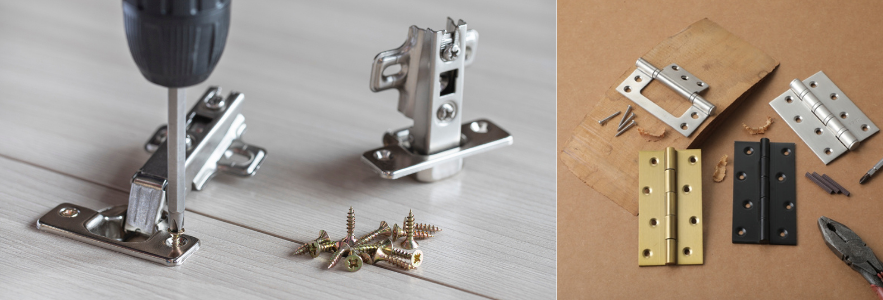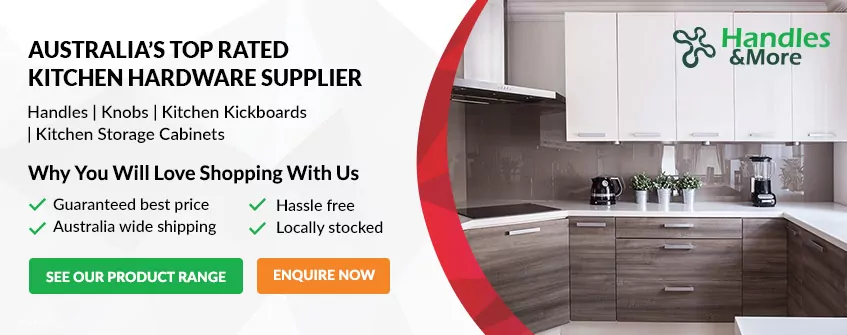Types of Cabinet Hinges – Their Features & Finishes
Did you know that there are numerous types of cabinet hinges having different looks, function, features and finishes? Here,...

Hinges are essential for cabinets as they help them open, close, and look good. There are many hinge styles to choose from, so you can find one that fits your style and needs. This guide will explain the different kinds of hinges, whether you’re fixing up cabinets or just want to learn about them.
Concealed Hinges: Concealed hinges are installed inside the cabinet, so you can’t see them when the door is shut. They give cabinets a smooth and classy look. They’re often used in modern kitchens and bathrooms with doors that cover the frame, making the space look clean and contemporary.
Overlay Hinges: Overlay hinges come in different types to fit various cabinet styles.
These hinges are popular for kitchen cabinets and bathroom vanities, each providing a unique design and functionality.
Butt Hinges: Butt hinges are classic cabinet hardware. They have two flat metal pieces connected by a pin in the middle, giving them a simple, lasting design. They’re easy to put on and care for and provide cabinet doors with solid support. Butt hinges work best for cabinets with doors that fit inside the frame, making them sit level with the cabinet.
Wrap Hinges: Wrap-around hinges resemble semi-concealed hinges, distinguished by an additional partial or complete wrap extending around the interior edge of the frame or further into the frame’s interior. Select these hinges to achieve the aesthetic of a semi-concealed hinge enhanced with superior support.
Think about the type of door cover you need. You have to choose the right hinge that fits the door style you’re making so the door sits just right without too much gap. There are two main types of door covers: inset doors, which sit inside the frame, and overlay doors, which sit on top of the frame and can either cover a bit of it or all of it. Check your cabinet designs to see which type of door overlay style will complement them.
Exposed hinges, such as butt hinges, are prominently visible and commonly found in traditional American and vintage cabinet styles. Conversely, concealed hinges provide a sleek exterior appearance, ideal for contemporary designs.
Motion features, such as soft closing hinges, are gaining popularity for their ability to reduce slamming noise and facilitate easy door closure, even when hands are full. Here are some popular motion features to consider:
Cabinet hinges are available in various sizes and uses, but they mainly fall into Traditional and European groups.
Selecting the right hinge finish is crucial for achieving the desired aesthetic in your space. Consider the cabinet material, surrounding decor, and personal preferences. Standard finishes include polished chrome for a modern look, antique brass for a vintage vibe, and matte black for a contemporary feel.
Considering the weight of the cabinet door is crucial when choosing the correct hinge type for several reasons:
By considering the weight of the cabinet door when selecting the hinge type, you can ensure proper functionality, longevity, safety, and aesthetic appeal.
If you need help selecting the right cabinet hinges for your Sydney home, contact Handles and More at 02 9757 4400. Our experienced and friendly team will be delighted to assist you.
Selecting the appropriate cabinet hinge is a crucial decision that can significantly impact your space’s functionality and aesthetics. Whether you opt for concealed or exposed hinges, consider factors such as style, motion features, and finish to ensure they complement your cabinets and overall design scheme.
By understanding the differences between hinge types and their respective advantages, you can make an informed decision that enhances the beauty and usability of your cabinets. Remember also to consider the longevity and durability of the hinges to ensure they stand the test of time.
With the right cabinet hinges in place, you can enjoy seamless operation, reduced noise, and a cohesive look that elevates the appeal of your kitchen or furniture. Take the time to explore your options and choose hinges that best suit your needs, style preferences, and budget.

Did you know that there are numerous types of cabinet hinges having different looks, function, features and finishes? Here,...